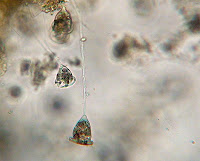During my lost observation I discovered many things. What I thought were Daphnia were, in fact, Lakane Rotifers. I also spotted some deflushia, or enclose amoeba, according to Dr. MacFarlane. Many of my organisms had grown significantly since my last post, and were quite fat. The Lakane Rotifers were the best growers, but the vorticella were also growing quickly.
I also noticed two interesting things pertaining to the invertebrates in the aquarium. First, I noticed a copepod, and secondly I saw what looked like the molted skin of an amphipod above the waterline of the aquarium.
During the time I was in the lab, the majority of my time was spent trying to learn what a particular cilliate was. Dr. MacFarlane and I spent over an hour observing it, taking photos, and filming it at a 40x objective to clearly see it's components. At the end of this time we determined that it must be a chlamydodon.
Pictures and film coming soon, I just need to get back in the lab and e-mail them to myself.
Cyanobacteria:

Chlamydodons:





















